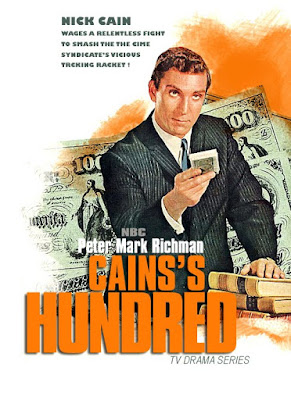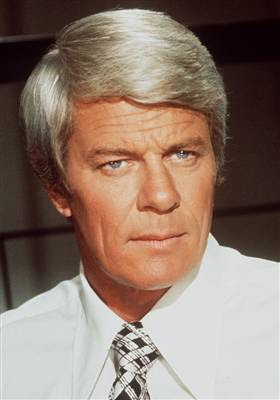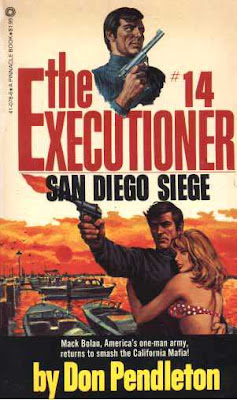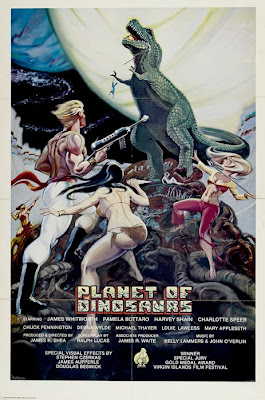
To remember Robert Culp, who passed away Wednesday at the age of 79, I watched two episodes of the shortlived TV series CAIN'S HUNDRED in which Culp guest-starred. More interesting is the fact that Culp also wrote one of them.
But first, a little information about CAIN'S HUNDRED. The NBC series debuted in the fall of 1961 with just one regular character: Nicholas Cain, played by actor Mark Richman (who later acted under the name Peter Mark Richman). Cain was a Syndicate attorney who decided to go straight after the murder of his fiancé. He joined the FBI as an agent, and dedicated himself to capturing America's top 100 mobsters.
Created by the bright Paul Monash, who later produced PEYTON PLACE and JUDD FOR THE DEFENSE before moving from television into motion pictures, CAIN'S HUNDRED was not successful. Much of the blame should fall on Richman, a dour leading man whose lack of humor and charisma extended to the rest of the show. The series contained little action, so if it's going to consist of white men standing around rooms and talking, it had better be good talk. It did draw terrific guest actors, such as Jack Klugman, Robert Duvall, Robert Blake, and David Janssen, and opened with a strong theme composed by Jerry Goldsmith, but it was just not a very good show.
It did, however, present Robert Culp with a screenwriting opportunity. At this point, he had only written one episode of TRACKDOWN, a one-season western in which Culp starred for Four Star Productions. The same year he appeared twice on CAIN'S HUNDRED, he also penned two teleplays for THE RIFLEMAN.
Culp's first appearance on CAIN'S HUNDRED was "The Plush Jungle," which aired January 2, 1962. It was written by Franklin Barton (later a producer of HAWAII FIVE-0) and directed by Alvin Ganzer.
Syndicate man Benjamin Riker (John Larch) sets his sights on Amalgamated World Transportation Company, which he believes will be perfect for his smuggling operations. To get the company, Riker sends his men (including Harry Dean Stanton) to strongarm Amalgamated's customers into taking their business elsewhere.
To help smooth the transition, Riker ingratiates himself with Amalgamated's vice president, Kurt Yoder (Culp in horm-rimmed glasses), who uses the opportunity to assert himself with his stern father Zales (Larry Gates), the president of Amalgamated. Culp is playing somewhat against type as a weak executive who is easily manipulated by the sinister Riker for his help in putting Riker's man on Amalgamated's board.
You'll notice I didn't mention Nicholas Cain in the previous synopsis. That's because he isn't much of a presence in the episode, and, in fact, may have less screen time than Culp does. Reportedly, the network and/or Paul Monash were becoming dissatisfied with Mark Richman's performance, and in some later episodes, Richman barely appears at all.
As for Culp, it's an interesting role that lets him play someone who isn't as confident as he usually played, but "The Plush Jungle" isn't terribly original or dramatically vivid. But his next CAIN'S HUNDRED segment gave him a juicier part.

Just three months after "The Plush Jungle," on April 3, 1962, Culp appeared in "The Swinger," for which he also provided the teleplay. Directed by Tom Gries, "The Swinger" stars Culp as nightclub singer Hank Shannon (who is unconvincingly doubled by Culp's friend Sammy Davis Jr., who also cameos). His old friend Nicholas Cain approaches Hank in Las Vegas to pump him for information about an upcoming summit of Syndicate men to be held at the home of Hank's friend Marcus Jackson (Bruce Gordon).
Now it's no surprise that Culp wrote a plum part for himself, but he also created a rich guest role for Gordon, who was famous at the time for playing Frank Nitti on THE UNTOUCHABLES. Jackson is another gangster, but one who has been beaten down by life, who has sacrificed his family obligations for the Mafia. Now, his wife is a vegetable in a hospital bed, and his 17-year-old daughter Lucinda (Zina Bethune, who would star on THE NURSES the following season), home from school for the holidays, despises him.
It's very strange to see Mark Richman relegated to third banana in his own series, but "The Swinger" is Culp's and Gordon's show all the way. Not only does Culp give himself plenty of the hip lingo he and Bill Cosby would sling around on I SPY, but he also gets to show off the fast draw he mastered on TRACKDOWN. Gries, later a two-time Emmy winner, lets the drama unfold in a lot of long takes. While, like "The Plush Jungle," there's no action, but a lot of talk, the dialogue is sharp and deep and sounds like it must have been fun for the actors.
Despite the creative success of "The Swinger," CAIN'S HUNDRED lasted only five more episodes. Richman went on to a long, successful career in television mostly, though occasionally in features; his tame spy flick AGENT FROM H.A.R.M. was mocked on MYSTERY SCIENCE THEATER 3000.
Robert Culp, of course, became a household name as the co-star of I SPY, an actor in dozens of films and television shows, and the star and director of the underrated crime drama HICKEY AND BOGGS, which sadly never received a DVD release during Culp's lifetime. While his CAIN'S HUNDRED appearances are pretty much forgotten today, at least one of them, "The Swinger," played an important part in Culp's career.
 John Wayne produced the 1956 western GUN THE MAN DOWN for his Batjac Productions. Filmed after GUNSMOKE’s first season on CBS, GUN THE MAN DOWN was the last feature film of James Arness’ career, one of the first for 25-year-old Angie Dickinson, who receives an “Introducing” credit, and the first for director Andrew V. McLaglen, who had been an assistant director on several Wayne films.
John Wayne produced the 1956 western GUN THE MAN DOWN for his Batjac Productions. Filmed after GUNSMOKE’s first season on CBS, GUN THE MAN DOWN was the last feature film of James Arness’ career, one of the first for 25-year-old Angie Dickinson, who receives an “Introducing” credit, and the first for director Andrew V. McLaglen, who had been an assistant director on several Wayne films. 















